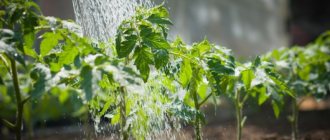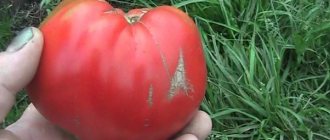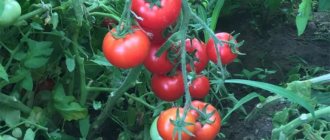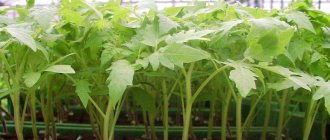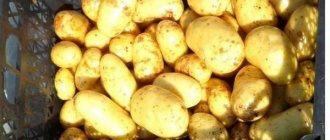Tomato One Hundred Poods: description of the variety
This tomato variety belongs to the indeterminate type,
therefore, its bushes are unlimited in growth, and in greenhouse conditions the shoots of the Hundred Poods tomato grow above 2 m. And in open ground the bushes reach a height of 1.4-1.6 m.
On a note!
The tomato variety One Hundred Poods is classified as mid-season - from the moment of germination of the seed material to the harvesting of ripe products, it takes about 4 months.
Photo of tomato One Hundred Poods
Shoots are weakly leafy. The foliage is elongated, of medium width, with sharp short tips, slightly curling inwards, slightly wrinkled, with clearly visible veins, emerald in color.
The flowers are yellow in color, small in size, collected in racemes. The first of them appears above 5-6 permanent leaves, the subsequent ones appear after a couple of leaves. Up to 7 flowers appear in each raceme, but fewer ovaries are formed in inflorescences - no more than 5.
Advice!
Foliage should be gradually removed from the shoots throughout the season so that most of the nutrients reach the ripening fruit. This measure is also an effective preventive measure against many diseases.
The shoots are too tall, so they should be tied up. In greenhouse conditions, trellises are used to secure the Hundred Poods tomato, and strong supports are used in the beds so that the stems do not break off under the weight of the ripening fruits.
Main characteristics of the variety
The fruits of the Hundred Poods tomato have an original shape - oval-pear-shaped, as well as clearly defined ribbing at the base of the tomatoes. Their weight is up to 160-250 g, but the first fruits that ripen in the lower part of the bushes can weigh more than 500 g with proper care.
The tomato variety Hundred Poods is considered large-fruited.
Ripening tomatoes have a green color, but as they ripen, the color of the skin becomes bright red.
Yield large-fruited tomatoes. Tomato “One hundred pounds” - video
On a note!
The pulp of the Hundred Poods tomato is compacted, fleshy, with a pleasant taste and a typical tomato aroma.
Each fruit can have up to 9 seed chambers with an average number of seeds and a small liquid content.
The skin of ripe tomatoes of the Hundred Poods variety is smooth, compacted, not prone to cracking, and is practically not noticeable when eating tomatoes fresh.
The harvested crop tolerates transportation well over any distance, while the tomatoes do not crack and do not lose their taste. At home, ripe fruits can be stored for up to 3 weeks, and they do not wither or spoil.
One Hundred Poods tomatoes have a universal purpose - they are consumed fresh, added to vegetable salads and snacks, and canned for the winter.
If the crop is harvested unripe, then all the fruits can ripen at home in a short time.
BEST TOMATOES!
Tomato GIGALO Tomato Benito F1 Tomato Spasskaya Tower F1
Reviews from gardeners who planted the variety
My variety “One Hundred Poods” grew very tall, in the spring it was under temporary shelter, and after May 15th I removed it. The tomatoes grew in the garden, but they were no less than 2.5 meters long. In mid-July they grew to the top of the stakes, to a height of 1.8 and began to hang down. The weight of the tomato was somewhere around 250-350 grams. I was very pleased with the taste and yield.
I decided to grow this variety every year - for the second year in a row it gives excellent results. Until mid-August, I managed to grow to 2 meters, the stepsons were “encrypted” and eventually grew into 3-4 trunks. Next year I want to try to initially form several trunks.
Caramel, Tver region
Tall. In the greenhouse it grew above 2.5 meters. Fruitful. I collected 4-5 kg from one bush. Didn't crack at all. Sweet, juicy, aromatic. Overripe and large tomatoes had small voids when cut. But the tomatoes were not dry. Good in salads. I tried canning it in slices.
Slysik, Krasnoyarsk Karaulnaya
The seeds were sown on March 14th. The first tomato ripened on July 15th. But the weight of the tomatoes was all 100-200g. The neighbors ripened much later, but the size was the same. I bought this variety on the advice of a friend. But apparently this was not his year. The taste is excellent, but some of the tomatoes are cracked.
Of the similar varieties planted this year (Aurea, Cuneo), I liked the Hundred Poods variety the most in taste. There were very few seeds, literally a few in each tomato. Not a single tomato cracked. It ripens well and is stored without loss of taste. I am very pleased with this variety and plan to plant it this year. I recommend it to everyone.
Diseases and pests
As a rule, the Hundred Poods tomato is practically not affected by the main diseases that are typical for other varieties of tomatoes and is not attacked by pests. However, pathogenic microorganisms and pests can enter the bushes of this variety from other cultivated plants or weeds.
To prevent the Hundred Poods tomato bushes from getting sick, it is necessary to take the following preventive measures:
- The soil must be disinfected before planting tomato seedlings;
- when growing a variety in greenhouse conditions, the room must be ventilated daily;
- Fertilizers are applied regularly to growing bushes;
- tomato bushes One hundred pounds are inspected daily in order to promptly detect symptoms of diseases or the appearance of pests;
- against the appearance of fungal diseases, tomato bushes One hundred pounds must be treated with a solution of Fitosporin or Bitoxibacillin.
Productivity
The Hundred Poods tomato is distinguished by a short period of fruit ripening. To get a massive harvest of tomatoes, at least 115 days must pass from the moment the seeds are planted. The speed of fruit ripening is influenced by the number of pickings and the ability of seedlings to adapt to new conditions.
As a rule, if all the rules of agricultural technology are observed, the first ripe tomatoes can be seen 45-50 days after planting the seedlings in a permanent place.
The yield of the Hundred Poods variety is quite high - about 6 kg per bush or up to 20 kg per square meter. m.
Pros and cons
The main advantages of the Hundred Poods variety include:
- although the variety is recommended for cultivation only in greenhouse conditions, in warm regions One Hundred Poods is also grown in garden beds in open ground;
- the bushes of this tomato do not require special careful care;
- high immunity, so the Hundred Poods tomato bushes are practically not affected by major diseases and are not damaged by insect pests;
- The yield of the Hundred Poods tomato is high;
- fruits are fleshy, tasty with a pleasant aroma;
- the taste of the Hundred Poods tomato is excellent;
- when grown by seedlings, after transplanting seedlings into open ground, ripe fruits are harvested after a couple of months - in mid-July;
- the harvested crop has a universal purpose;
- If the last fruits from the bushes are collected unripe, then they ripen well and quickly in room conditions.
There are practically no disadvantages to the Hundred Poods tomato variety. But we should not forget that the shoots of this tomato require mandatory gartering, the formation of bushes and the constant removal of stepsons.
Also, due to the large size of the fruits, they are not preserved entirely.
Agricultural technology
In central Russia, seeds are sown for seedlings in the first 2 weeks of March. Picking is carried out in the phase of 2 true leaves. Transplantation into the ground is carried out when the seedlings are 60 - 65 days old. In the southern and northern regions, the deadlines are adjusted. In the south you can sow seeds in mid-February, in cool areas - in late March - early April (for subsequent replanting in open ground). According to reviews, seed germination is not bad, not lower than 80%. The care of seedlings during cultivation is carried out as standard. The recommended planting density is 3 - 4 plants per 1 square meter. A tall tomato needs a garter - in open ground it can be grown as a stake crop, or in a greenhouse it can be tied to a trellis. To curb the growth of the bush, emerging stepsons need to be removed. In order for One Hundred Poods to show the best results, the plant is formed into 1 or 2 stems. Although some tomato growers left a larger number of stems as an experiment. But in this case, the weight of the fruit was below average. The variety loves watering and especially needs it in hot climates. But you shouldn’t get carried away; overwatering can lead to cracking of even unripe tomatoes. Our hero responds to high-quality fertilizing by increasing the yield; for this you can alternate organic matter and mineral fertilizers. Do not forget about preventive treatments; even a resistant crop needs protection.
In order to speed up the process of crop ripening in cool regions, experienced tomato growers remove foliage under the trusses that have begun to ripen. But it is not recommended to pick all the greens at once. This should be done gradually - no more than 2 - 3 sheets per week.
One hundred pounds is recognized by the majority of vegetable growers as an excellent crop with excellent varietal qualities, which one wants to plant every year. Moreover, once you have purchased the seeds, you can further prepare the seed material yourself. The plant is unpretentious; with standard care it will reward you with a good harvest. And many vegetable growers never cease to admire the taste of tomatoes grown in a sunny garden bed, which also have an amazing shape. The only inconvenience is the need to tie up the plants. But this is a necessary measure, since heavy brushes can easily bend or even break the stem. Finally, I would like to warn gardeners about the increasing incidence of mis-grading, which spoils the overall positive impressions of the variety.
Tomato One Hundred Poods: growing, planting seedlings and transplanting to a permanent place of growth
The Hundred Poods tomato variety is grown using the traditional seedling method. To do this, you first need to properly prepare the seed material.
Seed preparation
Tomato seeds One Hundred Poods, purchased in specialized stores, do not require pre-sowing preparation. They are only wrapped in a wet cloth for germination and left there for a day or two.
If vegetable growers leave seed material from their own bushes of a given variety, then they should be prepared in advance before planting them for seedlings.
First, they are lowered into a saturated saline solution and only those that have sunk to the bottom of the container are selected, and those floating on the surface are thrown out - they will not rise. Selected seeds are washed and dipped for half an hour in a weak solution of potassium permanganate for disinfection.
The disinfected seed material is then washed and wrapped in wet gauze for germination.
Once thin whitish sprouts appear, the seeds are ready for planting.
Review of TOMATO SEEDS. SORT OF HUNDRED POUDS - video
Preparing soil and containers
Soil for planting tomato seeds can be purchased in specialized stores, or you can prepare it yourself at home. For planting a Hundred Poods tomato, the nutrient substrate is prepared according to the same rules as for growing seedlings of other varieties of tomatoes.
Advice!
We should not forget that nutritious soil mixture prepared at home should be disinfected before placing it in containers.
To do this, you need to place the soil in an oven preheated to 180 degrees for half an hour, and after cooling, the soil is ready for planting seed material. You can also spill the nutrient substrate with a weak solution of potassium permanganate to disinfect it.
Containers for planting seeds are also disinfected before use.
Planting seeds
After the prepared nutrient substrate is laid out in containers, it should be moistened. And only then the seed is sown. A distance of 4.5 cm should be left between seeds and 10 cm between rows.
When planting, tomato seeds are buried 10 poods 10 mm into the soil. This is done carefully so as not to damage the emerging sprouts. Then spray the soil again from a spray bottle, cover the containers with polyethylene and place them in a warm, well-lit place.
Shoots appear 6-8 days after planting the seed.
After this, the plastic film is removed.
Features of cultivation
One hundred poods can be grown using the seedless or seedling method. Before sowing, seeds should be treated with Zircon growth stimulator. You can make the soil yourself by combining equal parts of garden soil, old humus or peat. You can also add superphosphate or wood ash to the soil mixture to increase the nutritional value of the soil.
The soil is poured into containers and the seeds are buried into it 1-1.5 cm with an interval of 2 cm from each other. The containers are covered with film and left in a room with a temperature of 25 degrees or higher. The film is removed when small sprouts appear on the surface of the earth. The boxes are transferred to a room with a lower temperature (17-18 degrees).
After the formation of 2 strong leaves, the seedlings are planted in separate cups and liquid complex mineral fertilizers are applied.
After 60 days, the seedlings can be transplanted into the greenhouse.
When growing the Hundred Poods tomato variety using the seedless method, the seeds are sown immediately in the holes, where humus is first added. Water the plantings with warm water. During 1 season it is necessary to feed the bushes 3-4 times:
- Before flowering, nitrogen fertilizers (azophoska) are applied;
- after the formation of the ovaries, fertilize with magnesium sulfate or superphosphate.
More information about growing tomatoes is described in the article: Technology of growing tomatoes. Secrets of planting and care
You might be interested in: How to properly plant tomatoes in a greenhouse: bush formation diagram, care features, photos and videos
Useful information: How to properly tie tomatoes in open ground: the best methods, step-by-step photo and video instructions
Further care
The Hundred Poods tomato does not require special care, but some agrotechnical measures must be carried out regularly.
Large-fruited, delicious varieties of tomatoes!
Tomato Mushroom basket Tomato Pink giant Tomato Heavyweight of Siberia
Irrigation regime
The Hundred Poods tomato requires frequent watering with warm, settled water, the main thing is not to overdo it so that there is no stagnation of moisture in the soil. Too much water in the soil can lead to the development of root rot.
In hot and dry times, it is necessary to water the bushes of this variety in the morning and evening hours; during the rainy period, the amount of watering is reduced.
Loosening the soil and tying up
After watering and rain, the root zone should be loosened to remove the resulting dry crust - it interferes with the penetration of oxygen into the soil.
Simultaneously with loosening, all weeds must be removed.
Advice!
The garter of tomato shoots is carried out when their tops begin to bend towards the ground. In greenhouses, it is better to tie bushes to trellises.
When the fruits begin to ripen, supports are placed under the clusters so that they do not break off under the weight of the ripening harvest.
All stepsons must be removed; they only take away nutrients. If this procedure is not carried out, the yield of this variety may decrease.
Feeding tomatoes
During the season, one hundred pounds of tomato should be fed according to the following scheme:
- after the seedlings acclimatize in a new place (12-14 days after transplantation), they need to be fed with complex
- mineral fertilizer, which necessarily contains phosphorus and potassium;
- before budding begins, fertilizing containing nitrogen is applied to the tomato bushes;
- During fruit ripening, superphosphate must be added.
Tomato care
It is necessary to care for the Hundred Poods variety, given that the tomato belongs to the indeterminate type and requires growth regulation.
Watering and fertilizing
It is enough to moisten the soil under tomatoes planted in a greenhouse or in a garden bed once a week, when the top layer dries out. The water is settled and, if possible, heated in the sun. Tomatoes are fed:
- 2 weeks after planting;
- when the flowers appear,
- during the formation of the ovary;
- before fruit ripening.
See also
Description of the large-fruited Scorpio tomato and features of growing the variety
Read
Chicken manure, mullein or mineral components in the form of superphosphate and magnesium sulfate are used as fertilizer. Fertilizing is combined with watering, loosening the soil, and hilling the plant.
Bush formation
When buds appear on the tomatoes, the top flowers are plucked, leaving up to 4 pieces, which helps to collect larger fruits. Lateral shoots 5 cm long begin to be removed as soon as the tomato takes root after transplantation. The lower leaves on the bushes are torn off and formed into 2 stems.
The shoots of the plant are attached to the frame. Supports are placed under the brushes on which the tomatoes are tied.
Disease and pest control
Although the Hundred Poods variety is immune to infection and is not afraid of mosaic and cladosporiosis, it attracts various insects. To prevent the development of diseases and pest damage, tomatoes are not planted after eggplants and potatoes; they are sprayed with Fitosporin, Bordeaux mixture or a solution of potassium permanganate.
When growing tomatoes in a greenhouse, the top layer is replaced with fresh soil every season. If parasites do appear, the bushes are treated with ash, infusions of celandine, and onion peels. Long before the fruits ripen, insecticides “Fitoverm” and “Akarin” are used.
Tomato One Hundred Poods: reviews from those who have already planted
On forums on the Internet you can find reviews about the Hundred Poods tomato - mostly gardeners are satisfied with the variety.
Vladimir, 45 years old, Volgograd region: I planted the Hundred Poods tomato variety three seasons ago and I can say that this variety is just a bomb. On the lower clusters, the fruits can grow weighing up to 700 g, but closer to the top the tomatoes become smaller - they grow no more than 300 g. In our region, we grow the variety directly in the open ground, where we plant the seedlings in the second ten days of April. For garter we put up trellises 2.5 m high. For watering, we arranged drip irrigation for the tomato bushes. As a result, from each square of area we collect about 20 kg of ripe fruits; this harvest is enough not only for food, but also for twists.
Tatyana, 40 years old, Novosibirsk region: I have been growing this variety in a greenhouse on the site for several years now. I really liked the Hundred Poods tomato – the fruits are large and tasty. The first fruits ripen completely on the bushes, and those that ripen in the second half of summer are collected at the stage of technical maturity and left to ripen at home. The taste of one hundred pounds of tomatoes ripening at home is, of course, worse than on the bush, but also quite tolerable.
Olga, 52 years old, Cheboksary: I planted this variety of tomato for the first time last season. I grew it in greenhouse conditions. The bushes grew up to 2.5 m in height, I tied them to trellises. As a result, it was easier to care for them, fertilize them and collect ripe fruits. The tomatoes grew large - up to 300-450 g with a pleasant sweetish taste and an unusual shape of the fruit. I will continue to grow it.
The Hundred Poods tomato is one of the best mid-season varieties that have recently been grown in different Russian regions in greenhouse conditions.
It is famous for its high yield, large fruit size, excellent taste and does not require special care. That is why it is so valued by the country's vegetable growers.



